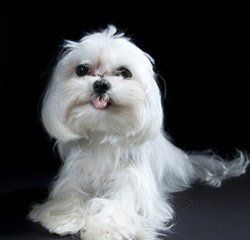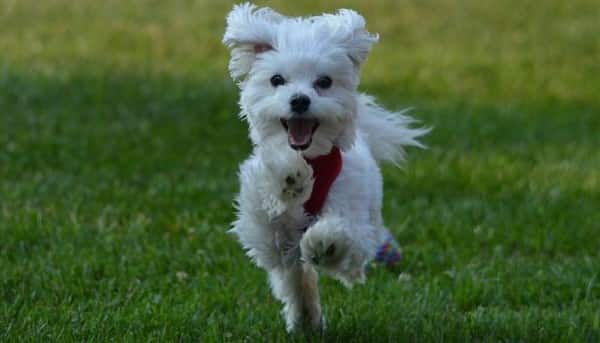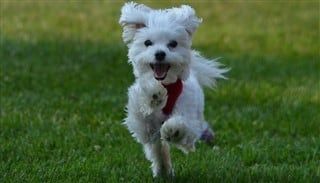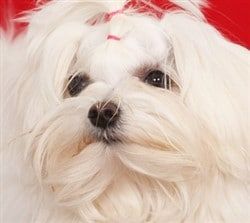Maltese Exercise
Little buddy, at 3 years old, photo courtesy of Stephanie Agostino
Overview
Though the Maltese is a very small toy breed dog, he does require purposeful exercise. It is important for both physical and emotional health.
In this section, we will discuss:
- Why exercise is important
- The age that you should begin taking your Maltese out
- Requirements of how long, how often, and at what pace a Maltese should be walked
- Other types of activity
- How to help your Maltese puppy or dog reach his exercise requirements
Please note:
PetMaltese is reader-supported. Some of the product suggestions on this page are affiliate links. As an Amazon Associate we earn from qualifying purchases. This is at no extra cost to you and helps us continue creating useful content.
Why it is Important to Exercise Your Maltese
Small dogs like the Maltese need exercise just like larger dogs do. Everything is relative, so small muscles on a small body need to be maintained. And a small heart on a small body needs to stay healthy.
In addition, toy breeds like the Maltese that have a boatload of energy may even need more activity (relatively speaking) than their larger counterparts.
There are quite a few reasons why regular exercise is beneficial.
There are physical reasons including:
- It is great for the heart, blood circulation, and for boosting the immune system
- Helps keep bones strong
- Maintains proper muscle mass
- Helps to regulate metabolism
- Encourages more robust eating
And there are behavioral/emotional reasons including:
- Satisfies the canine instincts of wanting new scents to sniff and new noises to hear.
- Prevents the canine equivalent of cabin fever; just being in an outside environment can lift the spirits of a dog that's been inside too long.
- Allows a healthy release of pent-up energy. If a puppy or dog does not have a way to let this out, it may negatively manifest in other ways including excessive barking, jumping, restless behavior, and/or sullen mood.
The Age You Can Start Taking Your Maltese Puppy Outside
You can start taking your Maltese puppy outside for exercise once he has received all of his puppy shots, plus two weeks. This is because newborn puppies receive antibodies via the dam and this protects them for a while. As those are waning off, vaccinations are taking place.
However, there is a window of susceptibility in which the antibodies from the dam are just about gone, however the ones that build up from the inoculations are not at full strength.
While you can bring your pup out into the yard if you are 100% sure that it is an area in which no other dogs have access to (except your own dogs, and only if they are up-to-date on shots), you will want to refrain from taking him out for walks until this window has passed.
You will want to double check with your vet; however, the typical age
that a Maltese puppy will be done with those puppy shots is the 4 month mark. If you play it safe and wait the additional two weeks, this brings you to the 4.5 month mark.
The Issue of Over-Exercising Puppies
You may have heard warnings to not over-exercise a puppy. This is indeed true; however, it is often misunderstood.
During the first 6 to 9 months, excessive exercise can interfere growth plate development. However, this refers to very intense physical exercise that really pushes a dog, and essentially brings him to his limit.
This would include such things as being urged to consistently run full-force, and other such sessions where the pup is under strain and stress.
Maltese Exercise Requirements
Frequency
- This breed does best with two walks per day.
Timing
- Generally, a morning walk and an evening walk are best.
Duration
- The walk should last for a minimum of 20 minutes and up to 30 minutes is fine for most Maltese.
You may take your Maltese out for even longer walks or to any sort of event in which there will be a lot of walking; however, you will want to plan for a break every 20 minutes or so for your puppy or dog to rest (preferably in the shade if it is hot out), and to have plenty of water to re-hydrate.
You may also find that if you take your Maltese to an event that does require lots of walking, that bringing along a canine carry sling like the i'Pet Hands-free Small Dog Sling Pouch
 will allow you to let him walk, but then easily carry him along with you should he tucker out.
will allow you to let him walk, but then easily carry him along with you should he tucker out.
Pace
- Aim to walk at a pace that is brisk for your particular Maltese. You will want him to be comfortably trotting, with an easy yet energetic gait.
Other Types of Activity
There are other types of activity that you can engage your Maltese in that count toward his daily exercise needs.
One thing that is not a substitution is simple indoor movement. There used to be a notion that toy breed dogs could 'self exercise' by staying busy inside; however, this is not true. All dogs move while indoors. So, walking, jumping, playing with other dogs, and other such actions are part of a dog's normal day.
For exercise, there needs to be moderate purposeful activity which engages the muscles and moderately rises the heart rate.
Since 5 minutes can feel like 25, and vice-versa, if you will be having an exercise session with your Maltese other than walking, it is suggested to time this.
Other activities include:
Fetch
- This classic game is one of the most popular for a reason; it not only gets a dog moving but is also a great bonding activity for owners and their canine family members.
Find it
- This is usually done indoors, and can be a good alternative if the weather is so severe that it's not possible to head outside.
This is done by hiding a toy or treat and encouraging a dog to find it. Start with an easy hiding spot, and work your way up to more challenging locations. Your level of enthusiasm will have a big impact on how focused your dog is, and to what extent he wants to play along.
Exercise Tips for Maltese Puppies and Dogs
There are several things that you can do to stay on track in meeting exercise goals:
1) Schedule the walks. It's easy to want to do something but then get lost in a busy day. However, maintaining your Maltese's health should be on the list of 'must do' tasks.
It can help to set specific times that you'll be heading out for a walk. If need be, other family members may need to be asked to step in and help with household chores.
Set an alarm to remind yourself that it's time to great ready to take your Maltese out for his walk.
2) Always stop at the designated bathroom area first.
It may seem easy to just let your Maltese pee or poo along the way; however, this is a missed opportunity to either house train or reinforce housebreaking
rules.
So, stop in the chosen bathroom area both before and after walks.
3) Don't let bad weather get in the way.
Unless there is a snow storm, sub-zero weather, or heavy rains, even toy breeds like the Maltese can be taken out for their daily exercise.
In the winter, the key is for both of you to dress warm. This single coated breed with hair (not fur) does better in cold weather with a small lined vest or other clothing like Onemore Choice's Outdoor Fleece-Lined Waterproof Dog Coat
 in which size extra-small fits most Maltese puppies and size extra-small or small is great for most adult Maltese.
in which size extra-small fits most Maltese puppies and size extra-small or small is great for most adult Maltese.
Year round, paws should be regularly protected with a quality paw wax. This protects from snowballing in the winter (small pieces of ice or snow that get stuck between toes or paw pads), frozen surfaces, and hot surfaces. A great one to regularly use is Musher's Secret Paw Protection Wax .
.
Spotlight Article
Exactly how to prevent discoloration on hairs all over the body and the 5 steps needed for your Maltese to have a pure white coat.

Best Shampoos for Maltese Dogs
- The type of products that are best for this single-layered, white coat

Maltese Care Tips
- The top 7 care tips for optimum health, comfort & happiness
How to help your Maltese better cope when he's home alone

-min-450x169-1920w.jpg)


-min-335x335-1920w.jpg)
-min-335x296-1920w.jpg)
